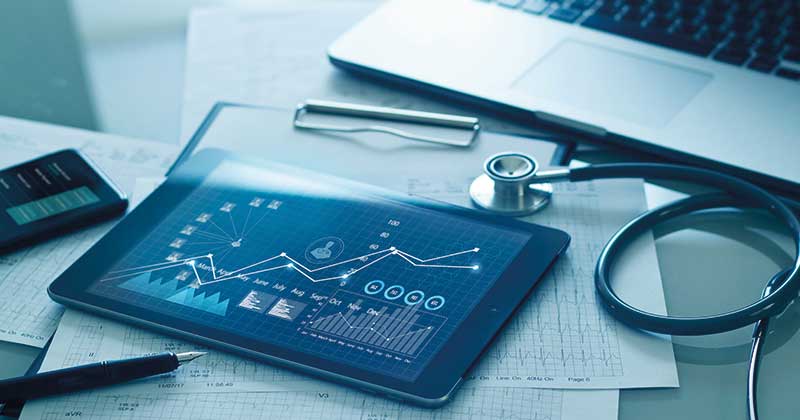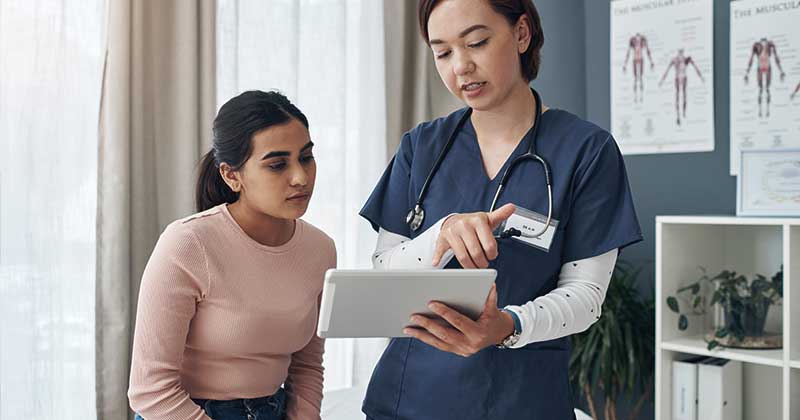Patient care remains the top priority for healthcare providers. But in a swiftly evolving technological world, conventional methods for managing and enhancing care might fall short. This is where real-time data analytics can make all the difference.
Real-time data analytics is an innovative tool revolutionizing healthcare operations and reshaping perspectives on patient outcomes. And with the potential to quite literally save lives.
This article explores how real-time data analytics help healthcare now and in the future. We’ll also look at how it can help you make more informed, impactful, and personalized patient care decisions.
RELATED ARTICLE: How Digital Transformation is Reshaping the Healthcare Supply Chain
What Are Real-Time Data Analytics?
Real-time data analytics refers to the instant gathering, processing, and analysis of data as it is created. Traditional data analysis relies on historical, structured data and operates on a delayed timeline. In contrast, real-time analytics delivers actionable insights that healthcare providers can use immediately.
Before diving into examples of real-time data, it’s essential to describe the four main types of healthcare data analytics. They include:
1. Descriptive: Focuses on understanding past data to identify basic trends and patterns.
2. Diagnostic: Explores the root causes of events.
3. Predictive: Uses historical and current data to forecast future outcomes.
4. Prescriptive: Recommends specific actions based on data analysis, optimizing outcomes.
Now that we understand the types of analytics, here are a few examples of sources for real-time healthcare data:
- Wearable devices like fitness trackers, cardiac bands, and smartwatches monitor health metrics such as heart rate, glucose levels, and physical activity.
- EHR (electronic health record) systems that maintain up-to-date medical records for instant access and analysis.
- IoT (Internet of Things) medical devices, such as remote patient monitoring (RPM) tools that track patient vitals from their homes, ensure ongoing care without hospital stays.
- Imaging systems and AI-powered diagnostic tools that analyze scans, X-rays, and lab results in real-time to identify critical issues immediately.
By leveraging these data sources, healthcare providers can move from reactive to proactive care models, creating a significant shift in how care is delivered.

How Do Real-Time Data Analytics Help Healthcare Providers?
The benefits of real-time predictive data analytics in healthcare go far beyond access to faster information. Here’s how it directly impacts patient care and the provider’s decision-making process.
Improving Day-to-Day Decision-Making
Utilizing artificial intelligence (AI) and machine learning (ML) in healthcare analytics is one way providers can improve day-to-day patient care. Real-time insights from this data allow healthcare professionals to act quickly in time-sensitive situations.
In an emergency room setting, AI can assist in the early detection of patients with life-threatening diseases and promptly alert providers so the patients can receive immediate attention.
For example, a wearable device may notify providers of a sudden drop in a patient’s oxygen levels, spurring immediate intervention to prevent a critical event.
Enhancing Care Coordination with Analytics
Medical team members can coordinate more effectively with real-time predictive analytics and data flowing seamlessly between departments. For instance, lab results can be instantly shared with physicians, surgeons, and specialists, enabling a faster and more unified treatment plan.
A case study from Perspectives in Health Information Management reveals one of the largest healthcare service providers in the state of Washington collected real-time data with advanced ML and AI algorithms and used it to:
- Coordinate patient care and resources across the entire health system.
- Streamline care delivery.
- Allow care teams to solve problems proactively.
By harnessing this technology, the system coordinated care more efficiently and improved safety for all its patients. For example, “lost cases” were reduced by 20 percent in the year’s first six months.
Through additional admissions and the prevention of lost cases alone, the program created a contribution margin equal to 74% of its labor cost in the first year of operations.
Better Care Decisions for Patients
Improving patient outcomes with predictive analytics in healthcare has come a long way. Access to real-time data allows for early diagnosis and targeted treatment plans tailored to each patient’s needs and circumstances.
One literature review states that this personalized treatment may include adjusting medication dosages and diet, recommending specific therapies, or considering differential diagnoses.
For example, oncologists can use real-time predictive analytics to identify effective chemotherapy protocols for specific cancer patients, improving treatment outcomes while reducing adverse effects.
Risk Management Through Healthcare Data Analysis
For patients with chronic or high-risk conditions, real-time healthcare data monitoring reduces the likelihood of hospital readmissions or adverse events.
For example, one literature review states that IoT systems use sensor data, which helps with the early detection of emergencies. These anomalies in vital signs can trigger automated alerts to family members, potentially saving lives, especially in elderly populations.
By analyzing real-time datasets, providers can also identify risk factors and predict which patients are most likely to develop certain conditions. This allows for earlier interventions that can prevent the onset of chronic diseases like diabetes.
FROM ONE OF OUR PARTNERS: The Role of AI-Enabled RPM in Delivering Better Health Outcomes

The Future of Real-Time Data Analytics in Healthcare
Real-time data analytics is already making strides in healthcare, but what’s ahead is equally exciting. Here are key trends to watch:
AI-Powered Analytics
Artificial intelligence is expected to enhance real-time predictive data analytics by offering even more precise prognoses and identifying patterns the human eye might miss.
Real-world example:
A report reveals that a new AI software is twice as accurate as physicians’ ability to examine the brain scans of stroke patients. The software could also estimate the biological age of the lesions, helping to determine whether the stroke may be reversible.
Wearables for a Healthier World
The growth of wearable devices will bring even more opportunities for personalized medicine through data analytics.
Real-world example:
Engineers developed a stretchy electronic skin patch worn on the neck to track blood pressure and heart rate while measuring the wearer’s levels of glucose, lactate, alcohol, or caffeine.
It’s the first wearable device that monitors cardiovascular signals and multiple biochemical levels in the human body at the same time.
Population Health Management and Analytics
By aggregating data from diverse sources, real-time analytics will become instrumental in managing population health. Providers will be able to address public health concerns more effectively by identifying trends and patterns within at-risk communities.
Real-world example:
Advanced home-based AI-powered remote patient-monitoring applications for users with multiple chronic health conditions are transforming population health management by gathering data elements in ways that previously proved impossible.
Piali De, CEO of Senscio Systems, tells Modern Healthcare, “Discovering correlations [within AI patient monitoring data] is the essence of population health management because it’s impossible to know what’s working for the most complex populations without the use of AI.”
How can healthcare providers drive adoption and innovation in data analytics? Here’s how:
- Educate and upskill: Stay informed by attending webinars and conferences, listening to podcasts, enrolling in data analytics courses, and keeping up with industry white papers and publications.
- Partner with tech providers: Collaborate with companies offering analytics platforms or wearable devices to explore innovative solutions tailored to your practice.
- Advocate for integration: Push for better integrating real-time analytics tools with existing EHR systems to improve data accessibility and usability.
RELATED ARTICLE: How Digital Patient Intake Streamlines the Check-In Process

How Healthcare Professionals Can Get Started with Real-Time Data Analytics
Want to dive into this new arena but unsure where to begin? Here are practical steps to help you integrate real-time analytics into your practice:
Invest in Scalable Technology
Start small with tools and software that offer immediate ROI. For instance, wearable devices for high-risk patients with chronic health issues or analytics platforms that plug directly into your EHR system.
Start with a Single Use Case
Focus on solving one problem at a time, such as reducing readmissions for a specific condition or improving appointment scheduling through predictive analytics.
Train Your Medical Team
Equip your staff with the knowledge they need to leverage analytics effectively. Provide training on interpreting real-time dashboards or using IoT devices to improve patient outcomes.
Leverage Pilot Programs
Test analytics solutions with a smaller group of patients or one department before scaling them to the entire practice.
Assess Your Current Systems
Evaluate your existing EHR, patient monitoring tools, and other technologies. Identify areas where real-time data could make the biggest impact (e.g., chronic care management, diagnostic imaging).
Also, make sure your practice software, which houses essential data and analytics, easily integrates with your EHR. For example, CollaborateMD is practice management software that can be seamlessly integrated with EHRs to improve clinical workflows and patient care.
This solution uses advanced real-time analytics to enhance patient data management, billing processes, effective care coordination, and communication. By leveraging this data, providers can:
- Refine treatment strategies
- Predict patent trends
- Intervene early and prevent adverse outcomes
- Improve patient engagement and boost revenue
Real-time data analytics has the potential to revolutionize how healthcare providers operate. Using tools that aggregate and analyze data instantaneously allows providers to make faster, more informed decisions while offering personalized, seamless patient care.
Are you ready to begin your data analytics journey?
Contact CollaborateMD today to see how integrated practice management software can support your practice goals and improve patient care.




